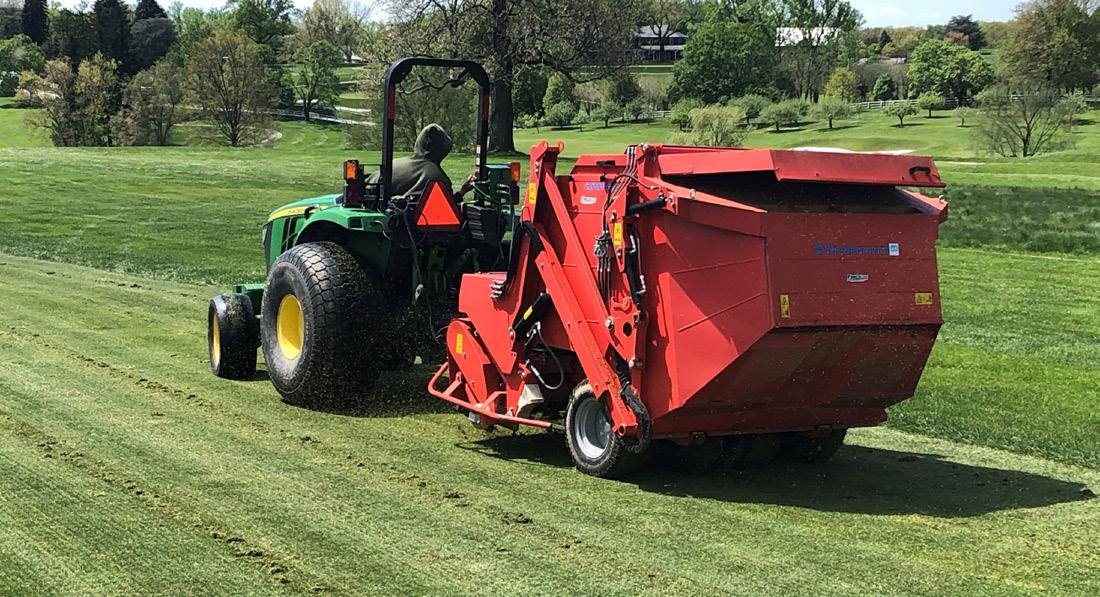
4 minute read
Grounds

GREENKEEPER'S UPDATE by Tim Kennelly, CGCS, Head Greenkeeper Aeration is necessary to relieve compaction, improve oxygen, stimulate new turf rooting in the soil, and improve water penetration and infiltration in the root zone. This year, our team aerated the West greens in late March by removing soil with 3/8" coring tines followed by light amounts of sand to smooth the surface. East Course aeration is scheduled for May 3 through May 5. We will be pulling small 1/8" cores followed by a light application of sand topdressing on the greens. We will also be aerating fairways with ½" solid tines followed by verticutting with Holes created by Ninja Tines the Wiedenmann pull-behind machine. These are tiny holes that are less disruptive than the standard coring tines and only disrupt 1% of the surface area. In 2020, we found this practice beneficial during the summer stress season (mid-June though mid-September) in providing healthy and quality playing surfaces. This month as the bermudagrass begins to grow, we will be verticutting the bermudagrass on the Driving Range and West Course tees in addition to the bentgrass. What exactly is verticutting? Verticutting is the thinning of turfgrass by blades or wire tines that cut perpendicularly to the soil in varying depths. This practice promotes both lateral and vertical growth, while deeper cuts into the soil reduce thatch and allow moisture and oxygen to reach the root zone. ◆ Aerating when the soil and surface temperatures are warm and the greens are actively growing, healing is much faster with reduced disruption time versus aeration in late March/ early April period. For the bentgrass greens, tees, and East fairways, the most important reason for aeration is the removal and reduction of thatch and organic matter. Thatch is a tightly intermingled layer of dead and living stems, leaves, and roots that accumulate between vegetation and soil surface. Thatch accumulation naturally occurs on creeping bentgrass surfaces. It can accumulate rather rapidly, negatively impacting turf growth and playability from reduced water infiltration and increased moisture retention resulting in a soggy surface. An excessive wet layer of thatch creates an excellent breeding ground for disease and pests. In addition to this core aeration, we will be frequently venting the green surfaces with Ninja Tines.


Wiedenmann pull-behind machine
COURSE CLOSURES
MAY
3-5 East Course closed (Aeration) 10 East Course closed (Aeration rain date) 17 West Course closed 24 West Course closed
JUNE
1 East Course closed 7 East Course closed 14 East Course closed 21 East & West closed (Private event) 28 East & West closed (Private event raindate)
BROOD X FAQ
17-YEAR CICADAS
For 17 years, cicadas do very little. They hang out in the ground, sucking sugar out of tree roots. Following this long hibernation, they emerge from the ground, sprout wings, make lots of noise that can exceed 100 decibels, reproduce, and die within a few weeks. Their offspring will then return to the ground and live the next 17 years in silence. Over the next several weeks, billions of MidAtlantic cicadas will hear the call of spring and emerge from their cozy bunkers. This year’s group, born in 2004, is known as Brood X. They’ll start their journey to the surface when soil temperatures reach around 64˚F. Cicadas appear every year on the East Coast, but it’s a different 17-year brood that wakes up each time. ◆
What geographic areas do the periodical cicadas affect?
Periodical cicadas are found in eastern North America. Within this region, there are different groups called broods that emerge on different 17-year cycles. Broods II, V, X, XIV, and XIX are found in Maryland, with Brood X being the largest. Maryland, Virginia, and Washington, D.C. are likely to host more of these insects than any other of the 14 states that share this experience.
How are periodical cicadas different from the cicadas I see every summer?
Periodical cicadas are smaller and have much more red-orange coloring than the common, large, green “dog day” cicada (genus Tibicen) we see and hear later every summer. Dog-day cicadas are not periodical. Although their life cycle is typically 2-3 years long, we see some emerging every summer.
Dog Day Cicada 17-Year Cicada
How long will periodical cicadas be out?
Adult periodical cicadas live between two and six weeks after they emerge from the ground. Adults will begin emerging in mid-May and will last through mid-June.
How many cicadas do we expect to see this year?
Cicada emergence density can be as high as 1.5 million per acre. (An acre is a little smaller than a football field!)
Will periodical cicadas eat or damage my flowers, shrubs, or trees?
Periodical cicadas do not damage flowers, but they may damage newly planted or young trees and some shrubs—damage results from female cicadas laying eggs in small twigs and branches, not from adult feeding.
Do cicadas bite or sting?
No. Cicadas do not sting like wasps and bees. Female cicadas have a blade-like organ called an ovipositor that they use just for laying eggs in twigs. Adult cicadas may make a loud buzzing sound if handled, but cannot bite or sting.
Why do we only see periodical cicadas every 17 years?
By coming out en masse, periodical cicadas are able to avoid or overwhelm enemies. No predator can possibly eat that many cicadas, so chances of individual reproduction and survival increase.
Active Periodical Cicada Broods of the United States ACTIVE PERIODICAL CICADA BROODS OF THE U.S.
Broods (Next emergence)
Multiple Broods
17-Year Cicadas
Brood I(2029) Brood II(2013) Brood III(2014) Brood IV(2015) Brood V(2016) Brood VI(2017) Brood VII(2018) Brood VIII(2019) Brood IX(2020) Brood X(2021) Brood XIII(2024) Brood XIV(2025)
13-Year Cicadas
Brood XIX(2024) Brood XXII(2014) Brood XXIII(2015)







